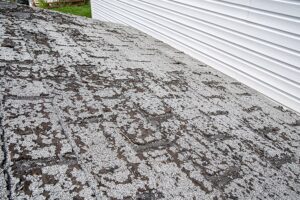Blistered Shingles: What It Is and How to Prevent It

Asphalt roofing is a popular pick for residential communities across the Tulsa metro area. This material boasts a host of properties that make it the perfect selection for the area’s climate, and area homeowners love it because of its durability, longevity, and affordability. That said, asphalt has some drawbacks, one of which is blistering.
Luckily, there are steps you can take to be proactive and reduce your risk of encountering this common roofing condition. Shamrock Roofing and Construction has created a simplified tutorial about blistering shingles and common causes, as well as preventive measures that will serve any Tulsa homeowner. Read on to learn more.
Shingle Blistering Defined
So, what exactly is a blistered shingle? Blistering occurs when shingles detach from the original underlayment, leaving an unsightly pocket of air. This air pocket may result in a bubbled or pockmarked appearance, depending on whether the bubble has popped or not. This situation creates an uneven (and dangerous) roof surface. This problem is mostly cosmetic, although if severe enough, it can also be a trip hazard for anyone walking on the roof. Most times, blistering doesn’t require extensive roof repair in Tulsa unless the blister bubbles pop.
When this happens, the primary matting becomes exposed, and the shingle loses its ability to protect your underlayment from UV exposure, rain, and other conditions that damage a roof. You may eventually experience premature warping, rot, and, ultimately, the need for a roof replacement.
What Causes Blistering?
There are a variety of conditions that can lead to the blistering of asphalt shingles. Hiring an inexperienced roofing contractor is a common one. Roofing is a specialized skill set that requires adherence to manufacturing guidelines and immense attention to detail. A roofer who takes shortcuts during the installation process may leave gaps on the roof’s surface that create a prime blistering habitat.
Poor ventilation and the introduction of moisture onto your rooftop are additional culprits. When hot, humid air can’t escape from underneath the roof, the temperature of the roof’s surface escalates. This is when blisters are likely to form. Similarly, if wet air is permitted to settle between the asphalt layers, bubbles can form, and blistering is the long-term result.
What Preventative Measures Can I Take?
If you’re concerned about your asphalt roof suffering from this condition, there are several ways you can independently minimize the risk of blistering. Scheduling regular roof inspections and maintenance with a team of experts on roofing in Tulsa is the easiest and most obvious first step. Regular check-ins give you the chance to identify and remedy any issues before they get out of hand.
Selecting a roofing contractor who’s experienced with this particular issue is also important. Last but not least, ensuring your home has the recommended number of ventilation outlets, ensuring these outlets are properly located, and regularly assessing their functionality are key preventative practices you won’t regret.
Looking for Help with Roofing in Tulsa? You’ve Come to the Right Place!
At Shamrock Roofing and Construction, we know you have many choices when it comes to hiring the right team for your roof repairs in Tulsa (or any roof maintenance concerns, for that matter). We’d love to earn your business by providing you with a free roof inspection. The resulting report will give you a good overview of the current condition of your roof. From there, we’ll be happy to answer any questions or concerns you have about asphalt blistering or anything else. Contact us today to get on our calendar. We look forward to working with you!